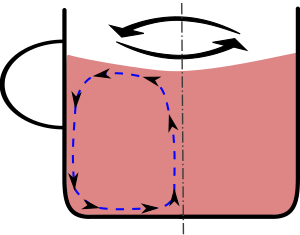Tea leaf paradox facts for kids
The tea leaf paradox is a cool science puzzle about what happens when you stir a cup of tea. You might expect the tea leaves to get pushed to the edges of the cup, like when you spin something fast. But instead, they move to the middle and sink to the bottom! This strange behavior was first explained by a scientist named James Thomson in 1857. He realized it had to do with how the water rubs against the bottom of the cup. Later, in 1926, Albert Einstein also wrote about this idea to explain why river banks wear away.

Why Tea Leaves Move to the Middle
When you stir tea, the water spins around in a circle. This spinning motion usually creates a force that pushes things outwards, like when you're on a merry-go-round and feel pushed away from the center. This is called centrifugal force. So, you might think the tea leaves, because they have weight, would be pushed to the edges of the cup.
However, something else important happens. The water rubbing against the bottom and sides of the cup creates friction. This friction slows down the water closest to the cup. This slower water creates an area of higher pressure right at the bottom and edges of the cup.
This area of higher pressure then pushes inwards. It's strong enough to overcome the outward push on the tea leaves. So, the friction between the water and the cup actually creates an inward force, called centripetal force, on the tea leaves. This force pulls them towards the center of the cup.
The way the water moves also changes because of this friction. The water at the bottom of the cup moves slower than the water at the top. This difference in speed makes the water twist into a spiral shape. The water moves outwards and up the sides of the cup, then it moves downwards, inwards, and finally upwards again in the center. This special spiral movement helps push the tea leaves towards the middle and keeps them from going to the edges.
How This Idea Is Used
The science behind the tea leaf paradox is not just for tea! It has been used in several useful ways:
- It helps scientists find new ways to separate red blood cells from blood plasma. This is important for medical tests.
- It helps us understand how weather systems work, like why certain air pressures form.
- It's used in making beer! Brewers use this idea to separate unwanted bits called trub from the liquid during the brewing process.
See also
 In Spanish: Paradoja de la hoja de té para niños
In Spanish: Paradoja de la hoja de té para niños



